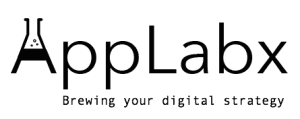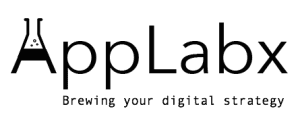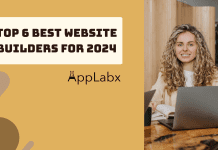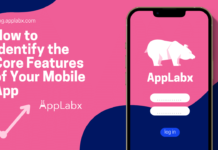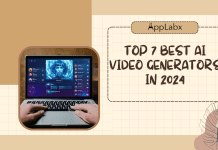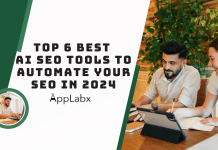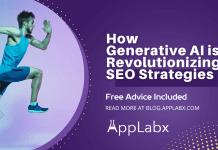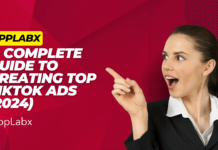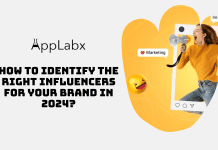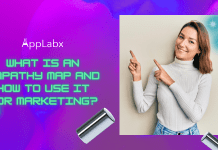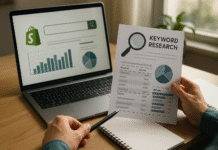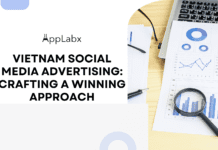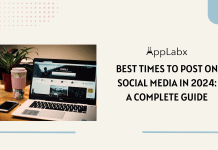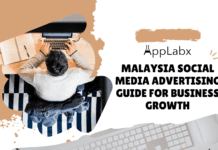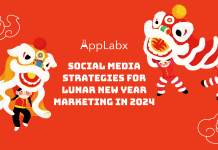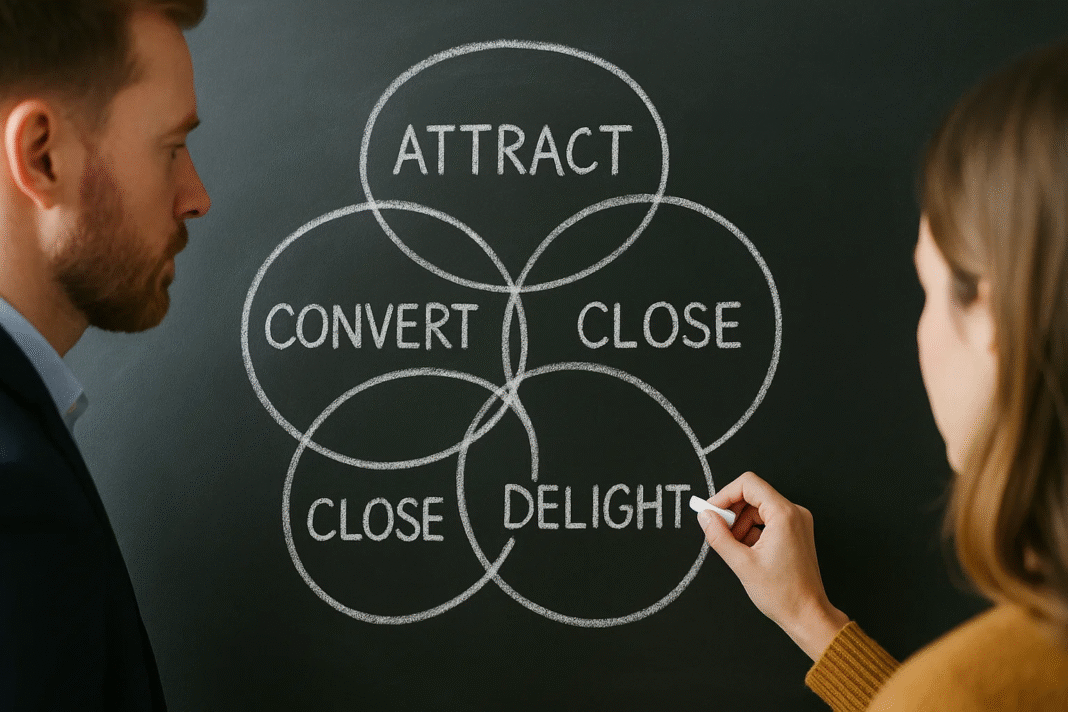Key Takeaways
- Understand how each stage of the inbound methodology helps move prospects from strangers to loyal brand advocates.
- Learn actionable strategies and tools to implement at every stage—from attracting visitors to driving referrals.
- Discover common pitfalls to avoid and how to align your teams for a seamless, growth-focused inbound journey.
In the digital age, where customer attention is fragmented and traditional advertising methods continue to lose their effectiveness, the inbound methodology has emerged as a game-changing strategy for sustainable business growth. Unlike intrusive outbound tactics—such as cold calls, unsolicited emails, or flashy banner ads—the inbound approach focuses on attracting, engaging, and delighting prospects by providing meaningful, helpful content that solves real problems. It aligns your marketing efforts with how modern consumers make buying decisions—by conducting research, comparing options, and trusting peer recommendations long before they speak to a salesperson.
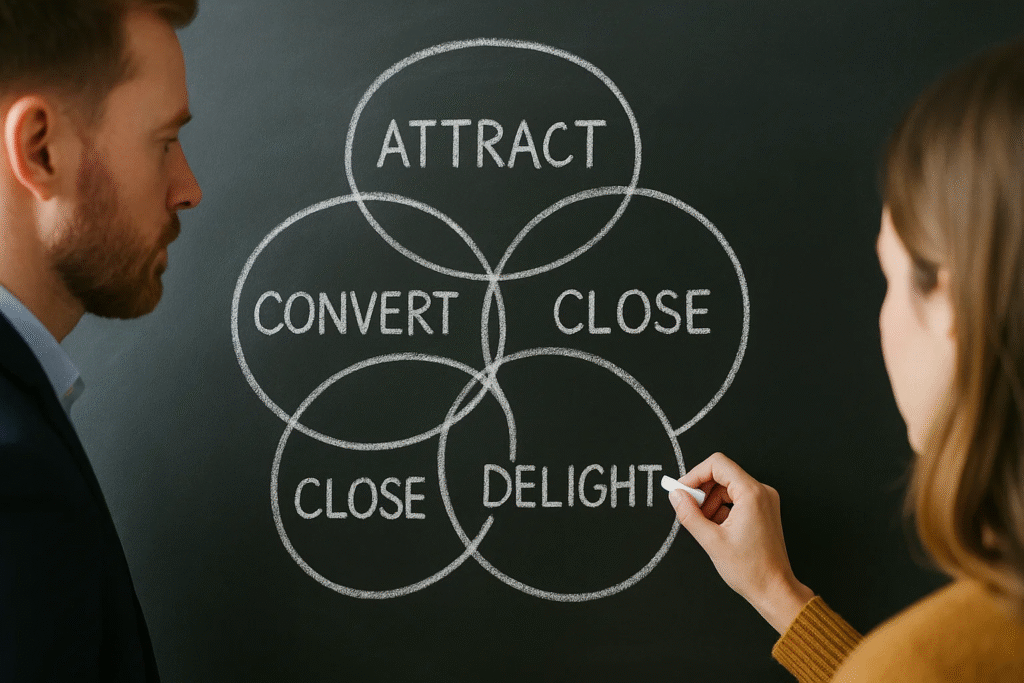
As businesses adapt to ever-evolving buyer behaviors, the inbound methodology offers a proven framework that puts the customer at the center of your marketing strategy. It doesn’t just generate traffic or leads—it nurtures long-term relationships, converts qualified prospects into loyal customers, and transforms those customers into powerful brand advocates. Whether you’re a startup looking to build brand visibility or an established enterprise aiming to scale customer acquisition, understanding the core stages of inbound is essential to staying competitive in today’s content-saturated market.
This blog post provides a comprehensive breakdown of the five essential stages of the inbound methodology—Attract, Convert, Close, Delight, and Advocate—while also offering actionable examples to help you implement each stage effectively. You’ll learn how to craft compelling content that draws in the right audience, use smart lead generation tactics to convert interest into action, and build automated systems to nurture leads through the funnel. More importantly, you’ll discover how to foster customer satisfaction and loyalty that drive organic growth through advocacy and referrals.
By the end of this guide, you’ll not only understand the theory behind each stage of the inbound methodology but also walk away with practical insights and strategies that you can apply immediately to your marketing efforts. Whether you’re new to inbound or looking to refine your current approach, this deep dive will serve as a valuable resource in creating a customer-centric marketing engine that fuels long-term success.
What Is the Inbound Methodology?
The inbound methodology is a strategic framework used by modern marketers and businesses to attract, engage, and delight customers by providing valuable content and personalized experiences. Unlike outbound marketing, which relies on interruptive tactics like cold calls, pop-up ads, or mass emails, inbound marketing draws people in by aligning with their interests and needs.
This methodology has become the foundation of customer-centric marketing—a philosophy that places the user’s journey, preferences, and trust at the heart of every brand interaction. The goal is to build lasting relationships, not just drive one-time sales.
Core Definition of Inbound Methodology
- A marketing and sales approach focused on providing helpful content to naturally attract potential customers.
- Involves creating valuable experiences tailored to a user’s stage in the buyer’s journey.
- Emphasizes pull marketing (drawing users in) over push marketing (broadcasting messages).
Inbound vs Outbound Marketing: Comparison Matrix
| Feature | Inbound Marketing | Outbound Marketing |
|---|---|---|
| Approach | Pull | Push |
| Focus | Value-driven content | Sales-oriented messaging |
| Audience Targeting | Persona-based, contextual | Broad and generalized |
| Communication Style | Two-way (interactive) | One-way (interruptive) |
| Cost Efficiency | Higher ROI over time | Expensive with declining effectiveness |
| Examples | Blogs, SEO, eBooks, webinars, automation | TV ads, cold calls, print ads, email blasts |
Why the Inbound Methodology Matters in 2025
- Evolving Consumer Behavior: Buyers now prefer to research online, read reviews, and compare solutions independently before making decisions.
- SEO and Algorithm Changes: Search engines increasingly prioritize user intent, relevance, and experience, favoring brands with strong inbound content.
- Privacy Regulations: As cookies disappear and data privacy laws grow, inbound strategies built on trust become more sustainable.
The Four (and Now Five) Stages of the Inbound Methodology
Originally defined in four stages, the inbound methodology now commonly includes a fifth: Advocate. These stages correspond to different steps in the buyer’s journey, ensuring a full-funnel approach from initial contact to brand loyalty.
1. Attract – Turning strangers into visitors
- Focuses on drawing in the right people using targeted, SEO-optimized content.
- Tactics: Blogging, social media, keyword optimization, video marketing
- Example: A SaaS company writes a guide titled “Top 10 CRM Tools for Small Businesses” to drive organic traffic from potential customers.
2. Convert – Turning visitors into leads
- Encourages users to take action and share their information in exchange for value.
- Tactics: CTAs, lead magnets, landing pages, forms
- Example: An e-commerce brand offers a free shipping coupon in exchange for email sign-up on a product landing page.
3. Close – Turning leads into customers
- Uses automation and sales alignment to guide leads toward a purchase decision.
- Tactics: Email nurturing, CRM workflows, lead scoring
- Example: A travel agency sends an email series to a user who downloaded a travel checklist, eventually offering a discounted package.
4. Delight – Turning customers into repeat buyers
- Aims to exceed customer expectations post-purchase to build loyalty.
- Tactics: Personalized onboarding, surveys, knowledge bases
- Example: A software platform offers free monthly training webinars for all active users.
5. Advocate – Turning loyal customers into promoters
- Focuses on leveraging satisfied customers to amplify your brand.
- Tactics: Referral programs, testimonials, user-generated content
- Example: A fintech app encourages customers to share video testimonials in exchange for premium account upgrades.
Inbound Methodology Flywheel vs. Funnel
While traditional marketers relied on a funnel model (linear path from awareness to conversion), modern inbound strategies use a flywheel model. The flywheel emphasizes momentum and growth powered by customer satisfaction.
Flywheel Model Explained
| Stage | Goal | Motion Drivers |
|---|---|---|
| Attract | Pull in potential customers | Content, SEO, Social Media |
| Engage | Build trust and relationships | Email, CRM, Conversational Bots |
| Delight | Provide exceptional experiences | Support, Loyalty, Feedback |
Visual Representation (Textual):
[Attract] → [Engage] → [Delight] → (Loop continues through advocacy and referrals)
Inbound Methodology Across the Buyer’s Journey
| Buyer’s Journey Stage | Inbound Stage | Primary Goal | Key Content Types |
|---|---|---|---|
| Awareness | Attract | Educate and inform | Blog posts, videos, infographics |
| Consideration | Convert | Generate and qualify leads | Ebooks, webinars, comparison guides |
| Decision | Close | Drive purchase decision | Case studies, demos, pricing pages |
| Post-Purchase | Delight/Advocate | Nurture loyalty and advocacy | Newsletters, referral programs, surveys |
Inbound Marketing Technology Stack (2025 Update)
To effectively implement inbound methodology, many businesses rely on a blend of tools and platforms:
| Function | Recommended Tools (2025) |
|---|---|
| CMS | WordPress, Webflow, HubSpot CMS |
| Email Marketing | Mailchimp, ActiveCampaign, ConvertKit |
| CRM | HubSpot CRM, Salesforce, Zoho CRM |
| SEO Optimization | SEMrush, Ahrefs, Surfer SEO |
| Automation | Zapier, Make.com, HubSpot Workflows |
| Analytics | Google Analytics 4, Hotjar, Looker |
Conclusion: Why Inbound Methodology Is Essential for Modern Growth
The inbound methodology is more than just a marketing tactic—it is a holistic business philosophy built on value, trust, and experience. In a digital environment where consumers demand authenticity and relevance, inbound offers a scalable and cost-effective way to:
- Attract high-quality traffic
- Nurture leads through educational content
- Convert prospects through smart automation
- Retain and delight customers
- Turn customers into advocates who fuel future growth
Whether you’re building a startup or optimizing an enterprise pipeline, mastering the inbound methodology is a long-term investment in brand authority, customer loyalty, and sustainable revenue.
But, before we venture further, we like to share who we are and what we do.
About AppLabx
From developing a solid marketing plan to creating compelling content, optimizing for search engines, leveraging social media, and utilizing paid advertising, AppLabx offers a comprehensive suite of digital marketing services designed to drive growth and profitability for your business.
AppLabx is well known for helping companies and startups use Inbound to drive web traffic to their websites and web apps.
At AppLabx, we understand that no two businesses are alike. That’s why we take a personalized approach to every project, working closely with our clients to understand their unique needs and goals, and developing customized strategies to help them achieve success.
If you need a digital consultation, then send in an inquiry here.
The 5 Stages of the Inbound Methodology Explained (with Actionable Examples)
- Attract (Turn Strangers into Visitors)
- Convert (Turn Visitors into Leads)
- Close (Turn Leads into Customers)
- Delight (Turn Customers into Promoters)
- Advocate (Turn Promoters into Growth Drivers)
1. Attract (Turn Strangers into Visitors)
The Attract stage is the foundation of the inbound methodology. It focuses on drawing the right audience—not just any traffic—to your website or digital ecosystem. Attracting strangers means providing value before they even consider buying, earning their attention through relevance, authority, and trust. The goal is to position your brand as a helpful resource, which naturally initiates the customer journey.
What Does ‘Attract’ Really Mean?
- It’s not about reaching the most people; it’s about reaching the right people.
- Attraction happens through content, search visibility, and strategic distribution.
- You must understand your audience’s pain points, search intent, and online behavior.
Key Objectives of the Attract Stage
| Objective | Description |
|---|---|
| Increase Qualified Traffic | Drive visitors who are likely to convert later |
| Build Brand Awareness | Position your business as a go-to expert |
| Improve SEO Visibility | Ensure your content ranks on search engines for relevant queries |
| Deliver Value Early | Offer actionable insights before asking for anything in return |
Core Strategies to Attract Visitors
1. SEO-Optimized Blogging
- Create high-quality, keyword-targeted blog posts that answer common questions.
- Focus on search intent: informational, navigational, transactional.
- Use SEO best practices: H1-H3 tags, schema markup, internal linking, optimized meta tags.
Example:
A B2B software company publishes a blog titled “How to Automate Sales Outreach in 2025” targeting the keyword “sales outreach automation tools.”
2. Social Media Marketing
- Share your content across platforms where your audience is active (LinkedIn, X, Facebook, TikTok).
- Repurpose long-form content into bite-sized posts, carousels, and videos.
- Leverage hashtags, user interaction, and community engagement.
Example:
An eCommerce skincare brand shares short educational reels explaining skincare ingredients linked to a blog post on their site.
3. Video Content and YouTube SEO
- Create how-to videos, explainer content, and educational series.
- Optimize titles, thumbnails, and descriptions for YouTube search.
- Embed videos in blog posts to enhance dwell time.
Example:
A SaaS company creates a YouTube video titled “CRM vs. ERP: What’s the Difference?” and embeds it into a related blog post for dual engagement.
4. Keyword Research and On-Page SEO
- Use tools like SEMrush, Ahrefs, or Ubersuggest to identify low-competition keywords with high intent.
- Map keywords to specific content types (e.g., blog, landing page, FAQ).
Example Keyword Mapping Table:
| Keyword | Search Intent | Content Type | Funnel Stage |
|---|---|---|---|
| “Best CRM tools for startups” | Informational | Blog Post | Awareness |
| “CRM vs. project management” | Comparative | Pillar Page | Awareness |
| “Free CRM trial” | Transactional | Landing Page | Consideration |
5. Guest Blogging and Backlink Outreach
- Publish articles on high-authority sites in your niche.
- Include contextual backlinks to cornerstone content.
- Build domain authority and referral traffic.
Example:
A marketing agency contributes a guest article to Moz.com on “AI-Driven SEO: The Future of Search in 2025”, linking back to their lead-gen blog post.
Persona-Driven Content Creation
Understanding your buyer personas is essential to attracting quality visitors.
| Buyer Persona | Pain Point | Content Angle | Channel |
|---|---|---|---|
| Startup Founder | Limited marketing budget | “Low-Cost Lead Gen Tactics for Startups” | |
| E-commerce Manager | High cart abandonment rate | “7 Ways to Reduce Cart Abandonment” | Facebook Ads |
| Marketing Director | Poor organic visibility | “Complete SEO Checklist for 2025” | Google Search |
Inbound Content Funnel (Top of Funnel)
| Funnel Stage | Content Type | CTA Example |
|---|---|---|
| Awareness (TOFU) | Blog posts, Infographics, Videos | “Read More,” “Watch Now,” “Learn How” |
| Engagement | Checklists, Quizzes, Podcasts | “Download Free Guide,” “Subscribe to Tips” |
The attract stage is all about TOFU (Top-of-Funnel) content that educates and sparks interest without being salesy.
Important Metrics to Track in the Attract Stage
| Metric | Why It Matters |
|---|---|
| Organic Traffic | Measures visibility in search engines |
| Bounce Rate | Indicates content relevance and engagement |
| Time on Page | Shows whether visitors find your content valuable |
| Social Engagement | Tracks content resonance on social media |
| New vs. Returning Visitors | Helps identify how well you’re attracting new potential leads |
| CTR (Click-Through Rate) | Measures effectiveness of headlines and meta descriptions |
Content Calendar Example (30-Day Inbound Attract Plan)
| Week | Content Type | Topic Example | Channel |
|---|---|---|---|
| 1 | Blog Post | “Top 10 Mistakes New Shopify Stores Make” | Organic Search |
| 1 | LinkedIn Carousel | “Inbound Marketing Funnel: Explained in 6 Slides” | |
| 2 | Video | “Why SEO Still Matters in 2025” | YouTube |
| 2 | Infographic | “Inbound vs. Outbound: Key Differences” | Instagram, Blog |
| 3 | Guest Post | “How to Drive Traffic with Long-Form Content” | Moz.com |
| 3 | SEO Audit Page | “Free SEO Checklist for Small Businesses” | Landing Page |
| 4 | Newsletter | “Best Inbound Tools to Watch in 2025” | Email Marketing |
Best Practices to Succeed in the Attract Stage
- Focus on value before selling: Don’t pitch; educate.
- Align content with search intent: Match the language and goals of your audience.
- Maintain consistency: Publish regularly across channels to build authority.
- Optimize every piece: Use on-page SEO, engaging visuals, and mobile-friendly formats.
- Cross-promote: Use email, social media, and partnerships to amplify your content.
Conclusion: Lay the Right Foundation
Attraction is not about generating empty clicks—it’s about establishing a meaningful connection with people looking for solutions. When executed correctly, the attract stage helps fill your pipeline with educated, qualified visitors who are far more likely to convert later. By focusing on SEO, helpful content, and persona alignment, you can ensure your brand becomes a trusted authority that naturally pulls potential customers toward your business.
2. Convert (Turn Visitors into Leads)
Once you’ve successfully attracted visitors to your website, the next critical phase of the inbound methodology is Convert—turning those anonymous visitors into qualified leads. At this stage, your goal is to collect meaningful data, such as names, email addresses, and behavioral insights, so that you can nurture these individuals through your funnel with relevant, timely, and personalized content.
Conversion is the bridge between awareness and engagement. It requires a careful balance of value exchange, persuasive design, and trust-building mechanisms to motivate users to take action.
What Is the Convert Stage?
- The process of encouraging visitors to share their contact details in exchange for high-value content or offers.
- Lays the foundation for lead nurturing, segmentation, and sales enablement.
- Should be non-intrusive, value-driven, and aligned with where the visitor is in the buyer’s journey.
Primary Objectives of the Convert Stage
| Objective | Description |
|---|---|
| Capture Lead Data | Collect emails, names, phone numbers, and business details |
| Deliver Value Immediately | Offer something of value in return (lead magnet, template, ebook) |
| Segment for Nurturing | Tag leads based on interest, behavior, or persona |
| Enable Automation | Feed leads into your CRM or email platform for follow-up |
Core Conversion Elements
1. Landing Pages
- Purpose-built web pages focused on a single conversion goal.
- Should eliminate distractions (no navigation menus, limited links).
- Must include a clear value proposition, visual hierarchy, and strong call-to-action (CTA).
Example:
A digital agency creates a landing page for its free downloadable guide: “30 Proven Lead Generation Tactics for B2B Brands” with a CTA: “Get the Guide”.
2. Lead Magnets
- Valuable resources offered in exchange for contact information.
- Should address a specific pain point or answer a common question.
Popular Lead Magnet Types:
| Type | Ideal For | Example Title |
|---|---|---|
| eBooks | Educating and building authority | “The Ultimate SEO Guide for Startups” |
| Checklists | Quick, actionable takeaways | “Launch Checklist for Shopify Stores” |
| Templates | Saving time and effort | “Email Campaign Calendar Template” |
| Webinars | High engagement and thought leadership | “How to Drive Organic Traffic in 2025” |
| Free Tools | Utility-based engagement | “Free On-Page SEO Analyzer” |
3. Forms and Smart Forms
- Embed forms on landing pages, popups, or blog posts to capture information.
- Use progressive profiling to ask different questions over time.
Best Practices:
- Ask only for essential information (e.g., name, email, company).
- Use multi-step forms for higher engagement.
- Integrate with CRM or email platforms for real-time sync.
4. CTAs (Calls-to-Action)
- Direct visitors toward conversion goals using buttons, banners, or text links.
- Should be visually prominent, verb-driven, and contextual.
CTA Copy Examples:
- “Download Now”
- “Get My Free Template”
- “Try the Demo”
- “Claim Your Discount”
CTA Optimization Table:
| CTA Type | Placement | Recommended Usage |
|---|---|---|
| Inline Text | Within blog content | Low friction, soft conversions |
| Slide-in Box | Side of screen while scrolling | Subtle prompt without disrupting reading flow |
| Pop-Up Modal | On exit intent or scroll | Use sparingly for lead magnets or limited offers |
| Button CTA | Homepage, landing pages | Strong directional prompts |
Behavioral Triggers for Higher Conversion
Use website analytics and behavioral data to optimize when and how to show your CTAs or lead capture tools:
- Exit-intent popups: Trigger when a user moves toward closing the tab.
- Scroll depth triggers: Show forms or offers once 60–70% of content is consumed.
- Time-on-page triggers: Display a conversion prompt after 45–60 seconds of engagement.
- Retargeting: Use cookies or pixels to re-engage visitors who didn’t convert.
Conversion Funnel Matrix
| Visitor Behavior | Ideal Conversion Offer | Funnel Stage |
|---|---|---|
| Reads blog post on SEO tips | eBook: “SEO Checklist for 2025” | Awareness |
| Visits pricing page | Free consultation call | Consideration |
| Engages with comparison content | Case study or demo request | Consideration |
| Returns frequently to product pages | Free trial or discount offer | Decision |
Technology Stack for Lead Conversion
| Tool Category | Recommended Platforms |
|---|---|
| Landing Pages | Unbounce, Leadpages, HubSpot CMS |
| Form Builders | Typeform, Gravity Forms, ConvertFlow |
| Email Capture | Mailchimp, ActiveCampaign, Klaviyo |
| CRM Integration | HubSpot CRM, Salesforce, Zoho CRM |
| Analytics | Google Analytics 4, Hotjar, Crazy Egg |
Real-World Example: Conversion Workflow
Scenario: A digital marketing firm offers services to local clinics.
Workflow:
- Traffic Source: Organic blog traffic from article “How to Market Your Private Practice Online”.
- Lead Magnet: Checklist – “10-Step Local SEO Plan for Clinics”.
- Landing Page: Includes form asking for name, email, and clinic size.
- Email Automation: Sends 3-part email series with actionable marketing tips.
- CTA in Email #3: Book a free 15-minute consultation call.
Result: Conversion rate increased by 42% compared to generic contact forms.
Important Metrics to Track in the Convert Stage
| Metric | Why It Matters |
|---|---|
| Conversion Rate | % of visitors turning into leads |
| Form Abandonment Rate | Indicates friction or complexity in your forms |
| CTA Click Rate | Tracks how well your call-to-action performs |
| Landing Page Bounce Rate | High bounce = poor targeting or irrelevant offer |
| New Leads per Source | Identifies which channels bring the most convertible traffic |
| Lead Quality Score | Measures how likely a lead is to become a customer |
Best Practices for Conversion Optimization
- Personalize content and CTAs based on traffic source, location, or device.
- Run A/B tests on CTA design, copy, and placement.
- Keep forms short and clearly communicate what users get in return.
- Build trust with testimonials, social proof, and data security badges.
- Deliver instantly – make sure the lead magnet is accessible immediately after submission.
Conclusion: Building a Lead Pipeline that Converts
The Convert stage is where inbound marketing begins to show measurable ROI. Instead of relying on hard sells, you offer solutions in a way that’s educational, non-intrusive, and deeply aligned with the user’s intent. By using strategic content offers, optimized landing pages, and targeted CTAs, businesses can convert passive visitors into active leads—opening the door to meaningful engagement and, eventually, sales.
3. Close (Turn Leads into Customers)
The Close stage of the inbound methodology is where the efforts from the Attract and Convert phases begin to materialize into revenue. This stage focuses on nurturing leads into paying customers using personalized communication, marketing automation, CRM data, and strategic sales enablement. Closing is not just about making a sale—it’s about providing the right solution at the right time based on trust and value alignment.
What Is the Close Stage?
- It involves transforming marketing-qualified leads (MQLs) into sales-qualified leads (SQLs) and ultimately into customers.
- Utilizes email marketing, CRM integration, lead scoring, and sales alignment to guide prospects to purchase.
- Prioritizes timing, personalization, and helpfulness rather than pushy sales tactics.
Primary Goals of the Close Stage
| Objective | Description |
|---|---|
| Nurture Leads | Use content and automation to build trust and deliver value |
| Qualify and Segment | Identify which leads are ready for sales outreach |
| Align Sales and Marketing | Ensure consistent messaging and lead handoff processes |
| Increase Conversion to Purchase | Convert leads into paying customers through effective touchpoints |
Core Components of the Close Stage
1. Customer Relationship Management (CRM) Systems
- Centralize contact data, interactions, and sales opportunities.
- Enable sales teams to personalize outreach based on lead behavior.
Popular CRMs:
- HubSpot CRM
- Salesforce
- Zoho CRM
- Pipedrive
CRM Benefits Table:
| Benefit | Impact on Close Stage |
|---|---|
| Lead tracking | Understand where leads are in the pipeline |
| Behavioral insights | Tailor messaging to actions taken (e.g., page views, email clicks) |
| Deal forecasting | Prioritize high-value opportunities |
| Task automation | Schedule follow-ups, assign tasks, and reduce manual workload |
2. Lead Scoring and Qualification
- Assign numeric values to leads based on behavior, demographics, and engagement level.
- Identify the highest-potential leads for immediate follow-up.
Lead Scoring Example Matrix:
| Criteria | Points | Description |
|---|---|---|
| Downloaded pricing guide | +10 | Indicates purchase interest |
| Opened last 3 emails | +5 | Shows high engagement |
| Visited pricing page 3x/week | +15 | Signals intent to buy |
| Generic email domain (e.g., Gmail) | -5 | Less likely to be a business decision-maker |
| Job title includes “Director” | +10 | Matches buyer persona |
3. Email Marketing and Lead Nurturing Campaigns
- Send personalized, automated emails to educate and persuade leads.
- Use drip campaigns to deliver content gradually based on lead stage.
Effective Nurturing Email Types:
- Educational content
- Product comparison guides
- Customer testimonials
- Case studies and ROI statistics
- Demo invitations
Lead Nurturing Flow Example:
| Day | Email Type | CTA |
|---|---|---|
| 1 | Welcome Email | “Explore Our Blog” |
| 3 | Educational Article | “Learn More” |
| 6 | Case Study | “See Real Results” |
| 10 | Product Comparison | “Download Comparison Sheet” |
| 14 | Free Demo Invite | “Book Your Demo” |
4. Sales Enablement Content
- Equip sales teams with content that helps close deals more effectively.
Key Enablement Materials:
- ROI calculators
- Sales decks
- Product comparison sheets
- Objection-handling scripts
- FAQ documents
Example:
A SaaS company provides its sales reps with a calculator that shows how much time and money a company can save by using their software compared to competitors. This tool is shared during demo calls to close deals faster.
5. Personalized Follow-Ups and Consultations
- Use behavioral data to follow up with leads via email, phone, or chat at the right time.
- Offer customized consultations, demos, or audits based on user needs.
Personalized Follow-Up Strategies:
- Mention the specific blog post or offer they downloaded.
- Reference their industry, company size, or challenges.
- Recommend a tailored product or service plan.
Example Follow-Up Email Snippet:
“Hi Sarah, I noticed you downloaded our B2B SEO Checklist. Based on your company’s profile, we believe our enterprise plan may align well with your goals. Would you be open to a 15-minute call this week?”
Aligning Marketing and Sales for Closing Success
Sales and marketing alignment is essential for efficient lead handoffs and higher close rates.
Smarketing Alignment Table:
| Marketing Responsibility | Sales Responsibility | Shared Goal |
|---|---|---|
| Generate and qualify MQLs | Convert SQLs into customers | Increased revenue |
| Deliver lead intelligence | Use intelligence to personalize outreach | Higher conversion rate |
| Create relevant content | Use content in sales conversations | Shorter sales cycle |
| Report on lead engagement | Report on close status | Funnel transparency |
Key Metrics to Track in the Close Stage
| Metric | Why It Matters |
|---|---|
| SQL to Customer Conversion Rate | Measures how many sales-ready leads become customers |
| Revenue Per Lead | Evaluates the monetary value of your leads |
| Sales Cycle Length | Helps identify inefficiencies in the closing process |
| Email Open and Click Rates | Indicates how compelling your nurturing content is |
| Deal Close Rate | Assesses sales effectiveness and conversion capability |
| Time to Close | Tracks the average number of days it takes to close a deal |
Real-World Example: Close Strategy in Action
Industry: B2B Tech Consulting
Lead Source: Whitepaper download from blog
Actions Taken:
- The lead received a 5-part nurturing email series.
- A sales rep reached out with a customized solution based on the lead’s company size and goals.
- Sales rep used a case study and ROI calculator to demonstrate value.
Results:
- Lead converted into a client after a 2-week nurturing sequence.
- Deal size: $18,000/year in recurring revenue.
Best Practices for a Successful Close Stage
- Use lead scoring to prioritize outreach to the most engaged contacts.
- Integrate your CRM with your marketing automation tools for seamless tracking.
- Personalize every sales interaction using CRM and behavioral data.
- Educate, don’t push—guide leads with useful content instead of aggressive selling.
- Track and optimize—regularly review your sales funnel data to improve performance.
Conclusion: Transforming Interest into Investment
The Close stage is where trust, education, and relevance come together to convert leads into paying customers. Through targeted communication, smart automation, and close collaboration between marketing and sales, businesses can ensure that their prospects feel understood, valued, and ready to take action. By leveraging CRM systems, lead scoring, and nurturing campaigns, this stage lays the groundwork for sustainable growth and long-term customer relationships.
4. Delight (Turn Customers into Promoters)
The Delight stage of the inbound methodology focuses on exceeding customer expectations after the sale is made. This phase is essential for building brand loyalty, generating repeat business, and creating customer advocates who promote your business organically. Rather than seeing the customer relationship as ending after a transaction, the Delight stage positions it as the beginning of a long-term partnership.
Happy customers are powerful assets—they leave positive reviews, refer others, and help lower your customer acquisition costs. In the inbound marketing ecosystem, this stage ensures the flywheel keeps spinning by transforming satisfied customers into loyal promoters.
What Is the Delight Stage?
- The Delight stage is about supporting, educating, and engaging customers after purchase.
- It aims to foster satisfaction, loyalty, and advocacy through meaningful post-sale experiences.
- Emphasizes customer-centric service, proactive communication, and value-added interactions.
Primary Goals of the Delight Stage
| Goal | Description |
|---|---|
| Increase Customer Satisfaction | Deliver exceptional experiences that surpass expectations |
| Drive Repeat Business | Encourage upsells, renewals, or cross-sells |
| Generate Referrals | Inspire word-of-mouth promotion and user-generated content |
| Enhance Lifetime Value | Keep customers engaged and buying longer-term |
Core Elements of the Delight Stage
1. Customer Success Programs
- Proactively guide customers to success with your product or service.
- Assign success managers or use automation to monitor engagement levels.
Customer Success Tactics:
- Onboarding emails and training sessions
- Knowledge base and help center
- Dedicated account managers for high-value clients
- Product usage tips based on activity
Example:
A project management SaaS provides onboarding webinars and account setup calls for new customers to reduce churn and boost activation rates.
2. Feedback and Surveys
- Collect feedback regularly to measure satisfaction and improve services.
- Use Net Promoter Score (NPS), Customer Satisfaction (CSAT), or Customer Effort Score (CES).
Customer Feedback Matrix:
| Survey Type | Purpose | Key Metric |
|---|---|---|
| NPS | Measures likelihood to recommend | Promoters, Passives, Detractors |
| CSAT | Measures satisfaction with a service | 1–5 or 1–10 scale |
| CES | Measures ease of task completion | 1–7 agreement scale |
Example Questions:
- “How likely are you to recommend our service to a friend?”
- “How satisfied are you with your recent support experience?”
- “How easy was it to resolve your issue today?”
3. Loyalty and Referral Programs
- Reward customers for repeat purchases or successful referrals.
- Increase retention and organic customer acquisition simultaneously.
Loyalty and Referral Strategies:
- Points-based rewards for purchases
- Discounts or credits for referrals
- Exclusive access to webinars, tools, or beta features
Referral Program Example:
| Action | Reward |
|---|---|
| Refer a friend | $25 gift card |
| Leave a public review | 10% off next renewal |
| Share on social media | Entry into monthly giveaway |
4. Educational Content and Customer Engagement
- Continue to deliver valuable content even after purchase.
- Help customers unlock full value from your products/services.
Post-Purchase Content Ideas:
- Advanced tutorials and guides
- Monthly newsletters with expert tips
- Product updates and feature walkthroughs
- Industry reports and whitepapers
Engagement Channels:
- Email newsletters
- Webinars and virtual events
- Private customer communities
- Social media listening and interaction
Example:
An analytics software company sends monthly reports showing usage statistics, personalized insights, and suggestions for improving performance.
5. Customer Support Excellence
- Responsive, empathetic, and multichannel customer support is key to delight.
- Live chat, ticketing systems, and AI chatbots enhance availability and scalability.
Support Performance Metrics:
| Metric | Description |
|---|---|
| First Response Time | Average time taken to respond to a customer |
| Resolution Time | Time taken to fully resolve an issue |
| Ticket Volume | Total support requests received in a period |
| Customer Satisfaction Rate | CSAT score collected after support interactions |
Support Channels:
- Email and live chat
- Knowledge base and community forums
- Social media direct messaging
- In-app messaging
Delight Stage in the Inbound Flywheel Model
| Flywheel Phase | Key Activity | Role in Delight Stage |
|---|---|---|
| Attract | Educational content | Re-engage and retain through ongoing learning |
| Engage | Personalized communications | Deliver targeted updates and features |
| Delight | Ongoing support and success enablement | Encourage advocacy and deepen trust |
Delight Tools and Technology Stack
| Tool Type | Recommended Platforms |
|---|---|
| Customer Support | Zendesk, Freshdesk, Intercom, Help Scout |
| Feedback & Survey | SurveyMonkey, Typeform, Hotjar |
| Email Automation | HubSpot, Mailchimp, ActiveCampaign |
| CRM Integration | HubSpot CRM, Salesforce, Zoho CRM |
| Loyalty/Referral Programs | ReferralCandy, Smile.io, Yotpo |
Real-World Example: Delight in Practice
Business Type: E-commerce subscription box
Actions Taken:
- Sent customers a satisfaction survey post-delivery
- Shared monthly unboxing tips via email and YouTube
- Offered a referral reward: “Get 1 box free for every 3 friends referred”
Results:
- NPS increased from 36 to 71 over 6 months
- 28% of new customers came through referrals
- Customer lifetime value (LTV) increased by 32%
Key Metrics to Track in the Delight Stage
| Metric | Why It Matters |
|---|---|
| Net Promoter Score (NPS) | Measures customer loyalty and advocacy |
| Customer Lifetime Value (CLV) | Shows the total revenue a customer is expected to generate |
| Repeat Purchase Rate | Indicates retention and satisfaction |
| Churn Rate | Measures how many customers you’re losing |
| Referral Conversion Rate | Tracks effectiveness of your referral programs |
| Support Ticket Satisfaction | Reflects the quality of post-purchase customer care |
Best Practices to Maximize Delight
- Be proactive, not reactive—reach out before issues arise.
- Continue the conversation—never stop educating your customers.
- Celebrate milestones—send thank-yous, birthday emails, and renewal rewards.
- Respond on all channels—engage customers where they prefer (email, chat, social).
- Ask for feedback—and act on it visibly to improve trust and loyalty.
- Reward loyalty—make customers feel appreciated and valued over time.
Conclusion: Creating a Flywheel of Customer Advocacy
The Delight stage is about making your customers feel so supported, successful, and valued that they voluntarily promote your brand. By investing in world-class support, educational engagement, and loyalty programs, businesses transform ordinary buyers into passionate brand advocates. This not only improves retention and lifetime value but also propels the inbound flywheel—driving referrals, lowering acquisition costs, and generating sustainable growth.
5. Advocate (Turn Promoters into Growth Drivers)
The final and often most underutilized phase of the inbound methodology is the Advocate stage. This is where loyal customers who have had a remarkable experience with your brand actively promote and endorse your business, serving as an authentic, influential growth engine. Inbound marketing doesn’t end at the point of sale—it flourishes when customers become brand ambassadors who expand your reach through trust and credibility.
In today’s landscape, peer influence is more powerful than brand messaging. Buyers trust online reviews, peer recommendations, and testimonials more than traditional ads. The Advocate stage allows you to harness this power at scale by turning satisfied customers into organic marketing channels.
What Is the Advocate Stage?
- The Advocate stage focuses on amplifying customer voices to attract and convert new leads.
- It transforms happy customers into brand evangelists who create and distribute user-generated content (UGC).
- This stage feeds the inbound flywheel, fueling growth with minimal cost and maximum authenticity.
Core Objectives of the Advocate Stage
| Goal | Description |
|---|---|
| Leverage Social Proof | Amplify trust through real customer stories and endorsements |
| Encourage Brand Advocacy | Motivate users to recommend your product or service |
| Strengthen Community Engagement | Create deeper connections with your audience |
| Reduce Customer Acquisition Cost | Drive referrals and word-of-mouth growth at a low or no cost |
Essential Components of the Advocate Stage
1. Customer Testimonials and Case Studies
- Use real success stories to build trust and credibility.
- Display testimonials across landing pages, product pages, and sales materials.
Case Study Format Example:
| Section | Example Content |
|---|---|
| Challenge | “Company A struggled to manage remote workflows across three regions.” |
| Solution | “Implemented Product X to unify project tracking and communication.” |
| Results | “Cut project delays by 42% and improved team efficiency by 65% in six months.” |
Where to Use Testimonials:
- Homepage banners
- Sales emails
- Landing pages
- Social media graphics
- Blog posts and video reviews
2. Referral Marketing Programs
- Encourage existing customers to refer new clients in exchange for incentives.
- Word-of-mouth remains one of the most trusted and effective marketing strategies.
Referral Program Matrix:
| Action | Incentive Provided | Target Audience |
|---|---|---|
| Refer a Friend | $25 account credit | General customers |
| Share on Social Media | 10% off next purchase | E-commerce customers |
| Write a Public Review | Free trial extension | SaaS clients |
| Submit a Video Testimonial | Exclusive merchandise | B2C and brand fans |
Example:
Dropbox’s iconic referral program offered users extra storage for inviting friends. This led to a 60% increase in signups and helped scale the platform in its early stages.
3. User-Generated Content (UGC) Campaigns
- Let customers create content around your product or service—photos, videos, blog posts, or social shares.
- Showcase UGC on your official channels to drive authenticity and engagement.
Types of UGC to Encourage:
- Before/after transformation videos
- Tutorials and product tips
- Customer unboxings
- Social proof screenshots (e.g., “loved by 10,000+ users”)
UGC Promotion Channels:
- Instagram highlights
- YouTube playlists
- Website galleries
- Blog roundups
Example:
GoPro encourages customers to upload action footage shot with their devices, which they feature in campaigns and contests—creating a powerful cycle of promotion.
4. Customer Advisory Boards and Brand Communities
- Involve power users in product development, feedback loops, and beta testing.
- Give them a sense of ownership, which deepens loyalty and promotes advocacy.
Advocate Community Engagement Activities:
- Invite to private Slack or Discord groups
- Offer early access to new features or launches
- Host advocate-only virtual meetups
- Send quarterly thank-you packages
Customer Advocacy Tier Chart:
| Advocacy Level | Description | Example Incentive |
|---|---|---|
| Level 1: Sharer | Social post or review | Branded swag |
| Level 2: Referrer | Repeated successful referrals | Account credits |
| Level 3: Influencer | Video testimonial or co-branded content | VIP access or revenue-sharing deals |
| Level 4: Evangelist | Public speaker or case study subject | Featured guest at events or webinars |
Performance Metrics for the Advocate Stage
| Metric | Description |
|---|---|
| Customer Referral Rate | Percentage of new customers acquired via referrals |
| UGC Submission Volume | Amount of user-generated content created and shared |
| Advocate Engagement Score | Frequency of participation in surveys, programs, or community events |
| NPS Promoter Utilization Rate | Percentage of promoters who actively engage in advocacy programs |
| Case Study Conversion Rate | Leads converted after viewing testimonial or case study |
| Social Share of Voice | Volume and sentiment of brand mentions across social platforms |
Technology Stack for Managing Advocates
| Tool Type | Recommended Tools | Use Case |
|---|---|---|
| Advocacy Platforms | Influitive, Ambassify, ReferralCandy | Managing advocate programs |
| Testimonial Collectors | Endorsal, Boast.io, VideoAsk | Capturing text/video testimonials |
| UGC Campaign Tools | TINT, Stackla, Yotpo | Aggregating and showcasing user content |
| Community Platforms | Circle, Discourse, Tribe | Building branded communities |
| Social Listening Tools | Brand24, Mention, Sprout Social | Tracking brand sentiment and advocacy trends |
Real-World Example: Advocates Driving Growth
Company: Canva
Advocate Strategy:
- Launched Canva Creators to showcase community templates
- Hosted social contests for design challenges
- Published customer stories featuring specific industries (education, marketing, non-profit)
Results:
- Generated over 100,000 UGC templates
- Boosted organic traffic and SEO visibility through community blog features
- Increased referral traffic by 40% year-over-year
Best Practices for Creating Customer Advocates
- Identify your promoters early using NPS surveys and engagement analytics
- Make advocacy easy and rewarding—minimize friction in referral or review submission
- Celebrate your advocates publicly through spotlights, shoutouts, and exclusive perks
- Create shareable moments—delight customers with surprise wins and branded experiences
- Track ROI from advocacy—use UTMs, referral codes, and surveys to measure outcomes
- Build two-way relationships—treat your advocates like partners, not just customers
Advocacy as a Long-Term Growth Strategy
| Advocacy Benefit | Strategic Impact |
|---|---|
| Low CAC (Customer Acquisition Cost) | Referrals and testimonials reduce marketing expenses |
| High Trust Conversion | Peer-to-peer promotion boosts lead-to-customer rates |
| Organic Content Growth | UGC supports SEO, engagement, and social reach |
| Community-Led Innovation | Customer feedback fuels product improvements |
| Flywheel Acceleration | More advocates = more leads = more promoters |
Conclusion: Advocacy Powers the Inbound Flywheel
The Advocate stage isn’t the end of the customer journey—it’s the multiplier effect that transforms great customer experiences into powerful marketing fuel. Through referral programs, user-generated content, testimonial showcases, and community building, businesses can activate their most loyal customers as ambassadors who drive sustained growth and visibility. When customers become your loudest champions, your brand builds reputation, reach, and revenue organically.
Let your customers be heard, and they’ll help your brand grow louder than any advertisement ever could.
Common Mistakes to Avoid in the Inbound Journey
While the inbound methodology is a proven framework for attracting, engaging, and delighting customers, many businesses fail to unlock its full potential due to avoidable errors. From misaligned content strategies to neglected lead nurturing, these mistakes can stall momentum, waste resources, and weaken customer trust. Identifying and addressing these pitfalls is essential to ensuring that each stage of the inbound journey functions efficiently and contributes to sustainable business growth.
This section outlines the most common inbound marketing mistakes, categorized by stage, along with actionable guidance, practical examples, and supporting data to help you stay on course.
Inbound Journey Overview
| Stage | Goal | Key Activities |
|---|---|---|
| Attract | Turn strangers into visitors | Blogging, SEO, social media |
| Convert | Turn visitors into leads | CTAs, landing pages, lead forms |
| Close | Turn leads into customers | CRM, email workflows, lead scoring |
| Delight | Turn customers into promoters | Support, surveys, educational content |
| Advocate | Turn promoters into drivers | Testimonials, referrals, brand engagement |
Attract Stage Mistakes
1. Targeting the Wrong Audience
- Creating content without a clear buyer persona
- Ignoring user intent in keyword selection
- Assuming demographics without validation
Impact:
- Low website traffic quality
- High bounce rates
- Poor engagement metrics
Example:
A B2B SaaS brand creating casual social media posts better suited for B2C lifestyle consumers.
Solution:
- Develop detailed buyer personas
- Use keyword research tools like SEMrush or Ahrefs to identify intent-based queries
- Map content to different stages of the buyer’s journey
2. Inconsistent Content Production
- Posting sporadically or neglecting evergreen content
- Failing to optimize existing content
Impact:
- Loss of SEO traction
- Reduced domain authority
- Poor audience retention
Content Production Frequency Matrix:
| Frequency | SEO Benefit | User Impact |
|---|---|---|
| Weekly | High | Consistent value, trust buildup |
| Bi-weekly | Moderate | Limited momentum |
| Monthly | Low | Minimal SEO impact |
| Ad hoc | Negligible | Erodes credibility |
Solution:
- Create an editorial calendar with content pillars
- Repurpose old content into new formats (e.g., blog → video → infographic)
Convert Stage Mistakes
3. Weak or Missing CTAs
- No clear call-to-action on high-traffic pages
- Using vague or generic CTAs (e.g., “Click here”)
Impact:
- Lost lead generation opportunities
- Poor click-through rates (CTR)
CTA Optimization Chart:
| CTA Type | Best Practice Example | Conversion Tip |
|---|---|---|
| Blog CTA | “Download the Free Checklist” | Align with content topic |
| Exit Intent Popup | “Get 15% Off Before You Leave” | Add urgency |
| In-line CTA | “Learn More About This Strategy” | Keep contextual |
Solution:
- A/B test CTA placement, color, and copy
- Use action-driven language tailored to the stage of the funnel
4. Poorly Designed Landing Pages
- Overly long forms
- Unclear value proposition
- Distracting navigation
Impact:
- High drop-off rate
- Low lead conversion rate
Landing Page Optimization Table:
| Element | Best Practice |
|---|---|
| Headline | Clear benefit-driven statement |
| Form Fields | Only ask for necessary info |
| Trust Elements | Include testimonials, security badges |
| Page Design | Minimalist with no top navigation |
Solution:
- Run usability testing with tools like Hotjar or Crazy Egg
- Ensure mobile responsiveness and fast load speeds
Close Stage Mistakes
5. Neglecting Lead Nurturing
- Sending the same email to all leads
- Ignoring segmentation and behavioral triggers
Impact:
- Leads go cold
- Low email open and click-through rates
Example:
Sending product-focused emails to leads who only downloaded a top-of-funnel eBook.
Solution:
- Use lead scoring to prioritize prospects
- Set up automated workflows based on user actions (e.g., opened email, visited pricing page)
6. Misalignment Between Marketing and Sales
- No shared understanding of qualified leads
- Lack of communication about lead behavior
Impact:
- Missed revenue opportunities
- Frustrated sales teams
Marketing-Sales SLA (Service Level Agreement) Template:
| SLA Metric | Marketing Responsibility | Sales Responsibility |
|---|---|---|
| Lead Definition | Define MQL/SQL criteria | Accept and act on qualified leads |
| Response Time | Notify sales of MQLs within 1 hour | Respond to MQLs within 24 hours |
| Lead Feedback | Provide lead history and source | Return feedback on lead quality monthly |
Solution:
- Integrate CRM and marketing automation platforms (e.g., HubSpot, Salesforce)
- Conduct monthly alignment meetings
Delight Stage Mistakes
7. Failing to Gather Customer Feedback
- Not surveying post-purchase experiences
- Ignoring negative reviews or complaints
Impact:
- Poor customer retention
- Missed opportunities for improvement
Customer Feedback Loop Process:
| Step | Tool/Method | Action |
|---|---|---|
| Collect | Surveys (NPS, CSAT) | Email automation, in-app forms |
| Analyze | CRM or analytics tools | Segment by satisfaction level |
| Act | Product team involvement | Improve features, resolve friction |
| Follow-up | Email or call | Close the feedback loop |
Solution:
- Schedule feedback collection at multiple touchpoints
- Implement issue-tracking and escalation workflows
8. Overlooking Post-Sale Education
- No product training or onboarding
- Lack of resources to ensure continued success
Impact:
- Higher churn rate
- Underutilized product features
Example:
A B2B tool that fails to educate users on integrations, leading to low adoption despite product fit.
Solution:
- Offer webinars, tutorials, and documentation
- Build customer success playbooks and onboarding sequences
Advocate Stage Mistakes
9. Ignoring Loyal Customer Advocacy
- Not asking satisfied customers for reviews or referrals
- No recognition or reward for advocacy
Impact:
- Missed opportunity for word-of-mouth growth
- Low referral traffic
Advocacy Activation Funnel:
| Stage | Customer Action | Brand Response |
|---|---|---|
| Satisfied | Leaves a positive review | Send thank-you email |
| Promoter | Refers a friend | Offer referral bonus or spotlight |
| Evangelist | Shares on social media | Invite to ambassador program |
Solution:
- Use platforms like ReferralCandy or Influitive
- Feature top advocates in newsletters and webinars
10. Not Measuring the Entire Funnel Holistically
- Optimizing top-of-funnel (TOFU) metrics without linking to revenue
- No full-funnel attribution
Impact:
- Misleading marketing performance data
- Budget misallocation
Inbound Funnel KPI Dashboard Example:
| Funnel Stage | Key Metrics |
|---|---|
| Attract | Organic traffic, SERP rankings |
| Convert | Lead conversion rate, CTA CTR |
| Close | MQL to SQL ratio, sales velocity |
| Delight | Retention rate, CLV, churn rate |
| Advocate | Referral volume, NPS, UGC quantity |
Solution:
- Implement multi-touch attribution models
- Track funnel performance through a central BI tool
Conclusion: Avoiding Pitfalls to Maximize Inbound ROI
Mastering the inbound methodology requires more than understanding the five stages—it demands operational excellence and continuous optimization. Whether it’s aligning marketing and sales, refining landing pages, or nurturing long-term customer relationships, every stage presents pitfalls that can derail success if left unchecked.
By proactively identifying and avoiding these common mistakes, businesses can:
- Enhance lead quality and conversion rates
- Improve customer satisfaction and retention
- Activate advocates who drive growth organically
- Create a more resilient, data-informed marketing engine
Inbound is not a campaign. It’s a long-term strategy built on trust, value, and relationships. And avoiding these mistakes is the first step toward achieving sustainable success.
How to Implement the Inbound Methodology in Your Business
Implementing the inbound methodology is not a one-time campaign—it is a strategic, ongoing transformation of how a business attracts, engages, and delights its audience. By aligning content creation, digital tools, and customer-centric processes across departments, companies can build long-term relationships that drive sustainable growth.
This section breaks down how to implement each stage of the inbound methodology, integrates key examples, tools, and metrics, and provides practical frameworks for turning strategy into action.
Step 1: Define Your Inbound Foundation
1.1 Develop Buyer Personas
- Conduct qualitative and quantitative research
- Interview existing customers and prospects
- Use CRM data to identify key behavioral trends
Example Persona Matrix:
| Persona Name | Job Title | Goals | Challenges | Preferred Channels |
|---|---|---|---|---|
| Startup Steve | Founder | Scale early-stage business | Budget, time constraints | Email, LinkedIn, Podcasts |
| Corporate Cathy | Marketing Director | Improve lead quality | Vendor overload, ROI tracking | Webinars, Whitepapers |
1.2 Map the Buyer’s Journey
- Awareness: Identify questions and problems users search for
- Consideration: Present possible solutions
- Decision: Offer specific product/service answers
Buyer Journey Content Alignment Table:
| Stage | Content Type | CTA Example |
|---|---|---|
| Awareness | Blog posts, infographics | “Read the full guide” |
| Consideration | Webinars, comparison guides | “Download the checklist” |
| Decision | Case studies, demos, free trials | “Schedule a consultation” |
Step 2: Attract the Right Audience
2.1 SEO Strategy and Blogging
- Perform keyword research using tools like Ahrefs or Semrush
- Create topic clusters and pillar pages
- Optimize on-page SEO (titles, meta, H1s, internal linking)
Example Topic Cluster:
| Pillar Content | Cluster Topics |
|---|---|
| Inbound Marketing Guide | Email Automation, Lead Magnets, CTAs |
| SEO for Startups | Keyword Research, On-Page SEO, Link Building |
2.2 Leverage Organic and Paid Channels
- Organic: LinkedIn posts, guest blogging, YouTube
- Paid: Google Ads, LinkedIn Sponsored Posts, Meta Retargeting
Channel Effectiveness Comparison Table:
| Channel | Cost | Lead Quality | Speed to Results | Ideal Use Case |
|---|---|---|---|---|
| SEO | Low | High | Long-term | Evergreen content |
| Google Ads | High | Medium | Immediate | Product launches |
| LinkedIn Organic | Low | High | Medium | B2B networking |
Step 3: Convert Visitors into Leads
3.1 Create High-Converting Landing Pages
- Use compelling headlines, trust indicators, and minimal form fields
- Include strong, relevant CTAs tailored to intent
Best Practice Landing Page Elements:
| Element | Best Practice |
|---|---|
| Headline | Clear value-focused message |
| Visuals | Product mockups or customer testimonials |
| Form | Ask only necessary information |
| CTA Button | Action-oriented text (“Get Your Free Trial”) |
3.2 Use Lead Magnets and Gated Content
- eBooks, whitepapers, case studies, templates
- Gate mid to bottom-funnel content behind forms
Example Lead Magnet Funnel:
| Lead Magnet | Buyer Stage | Conversion Goal |
|---|---|---|
| SEO Checklist | Awareness | Email subscriber |
| Industry Report | Consideration | MQL |
| Product Comparison | Decision | Free trial/demo signup |
3.3 Implement Conversion Tracking and CRM Integration
- Use tracking pixels and UTM parameters
- Integrate website with CRM tools like HubSpot or Salesforce
- Trigger automated workflows based on visitor behavior
Step 4: Close Leads into Customers
4.1 Lead Scoring and Segmentation
- Assign points based on engagement (email opens, page visits, etc.)
- Segment leads into Marketing Qualified Leads (MQLs) and Sales Qualified Leads (SQLs)
Lead Scoring Model Example:
| Action | Points |
|---|---|
| Downloaded a whitepaper | +10 |
| Attended a webinar | +20 |
| Visited pricing page | +25 |
| Unsubscribed from email | -10 |
4.2 Set Up Automated Nurturing Workflows
- Send personalized email sequences
- Use behavior-based triggers (e.g., visited product page = send case study)
- Provide educational content leading to product consideration
4.3 Sales and Marketing Alignment
- Develop SLAs between sales and marketing teams
- Regular sync meetings and shared dashboards
- Share feedback on lead quality and closed-won data
Example SLA Agreement Table:
| Metric | Marketing Target | Sales Commitment |
|---|---|---|
| MQLs per month | 100 | Follow up within 24 hours |
| Lead-to-close time | ≤ 30 days | Share conversion insights |
Step 5: Delight Customers Post-Sale
5.1 Customer Onboarding Programs
- Email onboarding sequences
- Welcome webinars and documentation
- Dedicated customer success managers
Customer Onboarding Funnel:
| Stage | Touchpoint | Goal |
|---|---|---|
| Week 1 | Welcome email + Setup guide | Product activation |
| Week 2 | Webinar invite | Feature discovery |
| Week 3 | Success check-in call | Prevent early churn |
5.2 Build a Customer Knowledge Base
- Tutorials, FAQs, and how-to videos
- Searchable documentation for self-service
5.3 Gather Feedback and Iterate
- Use tools like SurveyMonkey, Typeform, or Hotjar
- Collect Net Promoter Score (NPS) and Customer Satisfaction (CSAT) regularly
Step 6: Turn Delighted Customers into Advocates
6.1 Launch Referral and Loyalty Programs
- Offer incentives for referrals
- Create brand ambassador opportunities
Referral Program Structure Example:
| Referral Action | Reward |
|---|---|
| Refer a friend | $25 gift card |
| Leave a review | Entry into giveaway |
| Join affiliate program | 10% recurring commission |
6.2 Encourage User-Generated Content (UGC)
- Ask satisfied customers to share testimonials
- Host social media contests
- Feature customers in blog case studies
6.3 Showcase Success Stories
- Create in-depth case studies with ROI metrics
- Use quotes in landing pages, pitch decks, and ads
Full Funnel Implementation Dashboard
| Funnel Stage | Key Activity | Tools Used | KPI |
|---|---|---|---|
| Attract | Blogging, SEO | Ahrefs, WordPress | Organic traffic, CTR |
| Convert | Landing pages, CTAs | HubSpot, Typeform | Lead conversion rate |
| Close | CRM, email nurturing | Salesforce, Mailchimp | MQL → SQL → Customer rate |
| Delight | Onboarding, feedback | Intercom, SurveyMonkey | Retention, NPS |
| Advocate | Referral, UGC | ReferralCandy, G2 | Referral volume, Reviews |
Conclusion: Inbound Implementation as a Growth Engine
Implementing the inbound methodology is an evolving process, not a one-time setup. It requires the integration of strategic planning, content creation, marketing automation, customer success, and data analytics. When executed properly, inbound transforms businesses by:
- Increasing lead volume and quality
- Reducing customer acquisition costs
- Improving customer lifetime value
- Empowering happy customers to fuel growth organically
Every business, regardless of industry or size, can benefit from adopting an inbound approach tailored to their unique audience and objectives.
Conclusion
The inbound methodology is not just a marketing strategy—it is a philosophy and framework designed to put your audience at the center of every business interaction. By understanding and implementing the five distinct yet interconnected stages—Attract, Convert, Close, Delight, and Advocate—businesses can effectively guide strangers into loyal customers and, eventually, into powerful brand promoters who drive sustainable growth.
Why the Inbound Methodology Matters in Today’s Digital Landscape
In the age of information overload and shifting customer expectations, businesses that rely solely on interruption-based tactics (like cold calling, aggressive ads, or generic outreach) are at a clear disadvantage. Modern consumers are savvy—they research independently, compare options meticulously, and expect value before engagement. This is precisely where the inbound approach shines:
- It focuses on building trust, not chasing attention.
- It aligns marketing, sales, and service into a unified experience.
- It creates a scalable growth engine driven by content, automation, and personalization.
Inbound is the methodology that grows with your business, offering long-term benefits such as lower customer acquisition costs (CAC), higher customer lifetime value (CLTV), and more meaningful relationships with your audience.
Key Takeaways from the 5 Stages
Let’s revisit the purpose and power of each stage in the inbound journey:
| Stage | Purpose | Strategic Goal | Example Tactics |
|---|---|---|---|
| Attract | Draw in the right audience | Increase qualified website traffic | SEO, blogging, social media content |
| Convert | Turn visitors into leads | Build a lead database of engaged prospects | Landing pages, lead magnets, CTAs |
| Close | Nurture leads into paying customers | Improve sales conversion rate | Email automation, CRM integration, lead scoring |
| Delight | Enhance post-purchase experience | Boost retention and customer satisfaction | Onboarding workflows, knowledge bases, surveys |
| Advocate | Transform customers into brand promoters | Generate referrals and word-of-mouth growth | Referral programs, user-generated content, reviews |
Each stage builds upon the previous one. Neglecting even a single step weakens the overall funnel, leaving gaps in the user experience that can result in missed opportunities and churn.
Avoiding Common Pitfalls
To maximize your inbound success, be sure to:
- Consistently create audience-first content across channels
- Keep your messaging aligned across marketing, sales, and service
- Use data and feedback to iterate and optimize every touchpoint
- Never lose sight of the buyer’s journey—context is key
Inbound is dynamic, and so are your customers. The brands that win long term are those that commit to continuous improvement, cross-functional alignment, and value-driven engagement.
Implementing Inbound: Final Words of Guidance
Whether you’re just starting your inbound journey or looking to refine an existing strategy, here are final tips to keep in mind:
- Start with Strategy: Don’t rush into tactics. Define your buyer personas, set SMART goals, and map out the buyer’s journey clearly.
- Invest in Tools Wisely: Marketing automation, CRMs, and analytics tools (like HubSpot, Salesforce, Google Analytics) are key enablers.
- Measure What Matters: Track KPIs like conversion rates, customer acquisition cost, email engagement, and NPS to guide decision-making.
- Educate Continuously: Inbound trends evolve—stay updated through certifications, industry blogs, and continuous team training.
- Deliver Value at Every Stage: From the first blog post to customer support emails, always prioritize helpfulness and relevance.
Inbound Is a Growth Philosophy, Not Just a Marketing Channel
Ultimately, inbound is not a fixed playbook—it’s a mindset of putting the customer first, delivering genuine value, and building authentic relationships over time. When embraced fully, it transforms not just how you market, but how you sell, serve, and scale.
If you’re ready to turn traffic into leads, leads into customers, and customers into advocates, now is the time to implement the inbound methodology. It’s not about overnight results—it’s about long-term, compounding returns on relationships, trust, and helpfulness.
Looking to get started? Consider auditing your current marketing funnel using the inbound stages as your framework—and start filling in the gaps today.
If you are looking for a top-class digital marketer, then book a free consultation slot here.
If you find this article useful, why not share it with your friends and business partners, and also leave a nice comment below?
We, at the AppLabx Research Team, strive to bring the latest and most meaningful data, guides, and statistics to your doorstep.
To get access to top-quality guides, click over to the AppLabx Blog.
People also ask
What is the inbound methodology?
The inbound methodology is a customer-centric approach focused on attracting, converting, closing, and delighting customers using valuable content and experiences.
What are the five stages of the inbound methodology?
The five stages are Attract, Convert, Close, Delight, and Advocate—each guiding prospects through a journey from stranger to promoter.
How does the ‘Attract’ stage work?
The Attract stage uses SEO, blogs, and social media to draw in the right audience with relevant, helpful content.
What tools are used in the Convert stage?
Tools like landing pages, forms, lead magnets, and CTAs are used to convert visitors into leads during this stage.
What is the goal of the Close stage?
The goal is to turn leads into paying customers through lead nurturing, email automation, and sales alignment.
Why is the Delight stage important?
Delighting customers ensures satisfaction, boosts retention, and encourages long-term loyalty to your brand.
What happens in the Advocate stage?
Happy customers become brand promoters by leaving reviews, referring others, and sharing positive experiences.
How does content support inbound marketing?
High-quality content educates, engages, and builds trust throughout all five stages of the inbound journey.
What is a buyer persona in inbound marketing?
A buyer persona is a semi-fictional profile representing your ideal customer, used to tailor content and strategy.
How does SEO fit into the Attract stage?
SEO ensures your content ranks high in search results, increasing visibility and drawing in qualified visitors.
What’s a good example of a lead magnet?
A free eBook, checklist, or template offered in exchange for a visitor’s contact information is a lead magnet.
How can email automation help in the Close stage?
Email automation nurtures leads with personalized messages that guide them toward making a purchase decision.
What metrics should you track in the Delight stage?
Track metrics like customer satisfaction (CSAT), Net Promoter Score (NPS), and customer retention rates.
How can businesses encourage customer advocacy?
Offer referral programs, collect testimonials, and feature user-generated content to foster brand advocacy.
What’s the difference between inbound and outbound marketing?
Inbound pulls in leads through valuable content, while outbound pushes messages through ads or cold outreach.
How do you measure inbound marketing success?
Use KPIs like website traffic, conversion rates, lead quality, customer acquisition cost, and customer lifetime value.
What’s the role of CRM in inbound marketing?
CRM helps track interactions, segment contacts, and personalize communication at every stage of the funnel.
Why is lead nurturing essential in inbound marketing?
Lead nurturing builds trust over time, moving prospects through the funnel until they’re ready to buy.
How do you align sales and marketing in the inbound methodology?
Align teams through shared goals, integrated tools, and consistent communication to close leads more effectively.
What content works best in the Consideration stage?
Comparison guides, case studies, and webinars help prospects evaluate solutions and narrow their options.
How do blogs contribute to the inbound process?
Blogs drive organic traffic, answer questions, and establish authority, particularly in the Attract and Convert stages.
Can inbound work for B2B businesses?
Yes, inbound marketing is highly effective for B2B, especially with long sales cycles and informed buyers.
What is a call-to-action (CTA) in inbound marketing?
A CTA prompts visitors to take the next step, such as downloading content, signing up, or contacting sales.
How can social media support inbound marketing?
Social platforms help amplify content, engage audiences, and attract new visitors in the early stages.
What’s an example of the Delight stage in action?
A SaaS company offering personalized onboarding and proactive customer support after signup is delighting customers.
How often should you update inbound content?
Regular updates keep your content relevant, maintain rankings, and improve performance across all stages.
What are the most common inbound marketing mistakes?
Mistakes include lack of persona research, weak CTAs, inconsistent follow-up, and misaligned sales-marketing efforts.
How can you optimize conversion rates in the inbound funnel?
Use A/B testing, personalized CTAs, and streamlined forms to improve conversion rates at every stage.
Is inbound marketing cost-effective?
Yes, inbound typically costs less than outbound and delivers compounding returns over time through organic growth.
How long does it take to see inbound marketing results?
Inbound results can take 3–6 months to materialize, depending on content consistency, SEO efforts, and lead nurturing.
